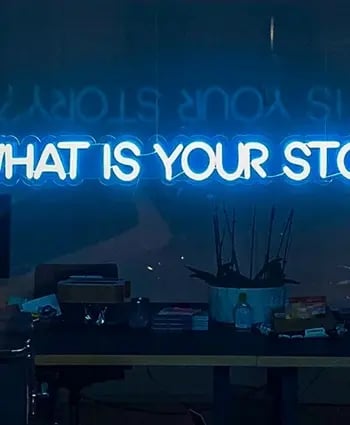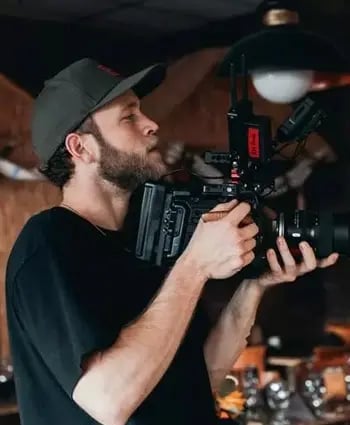Tell Stories that Sell: the Best Customer Success Story Template
All the best case studies & customer success stories follow a simple but effective template that's actually a classic story structure. This post will walk you through it (plus examples) & download our guide.
How do you encourage leads to jump that final hurdle and buy from you? One of the most powerful ways is with a customer success story.
Case studies & success stories let you showcase one customer's experience as an example of what to expect from you and your product or service.
Case studies and customer success stories give you the chance to:
- Address the challenges your target audience face
- Embrace the authenticity of a real client
- Ease any concerns potential customers may have
As long as you don't forget the golden rule, that is.
What's the golden rule?
A great customer success story needs to be a great story, too. [Tweet this]
Whether they're told through text, audio or video, all the best case studies follow a very simple but very effective template. It's a classic story structure that you'll be familiar with from basically every book, movie and play you've ever seen.
Most importantly, it works, giving you the power to touch the hearts and convince the heads of your leads, hopefully converting them into buying customers along the way.
And I'm going to walk you through that template now.
The Best Template for Telling Customer Success Stories (in 4 Steps)
1. Set the Scene & Introduce the Hero
 In a small town there lives a brave knight. He spends his days keeping the townsfolk safe and generally doing good. The smiles on their faces make all his battles worthwhile.
In a small town there lives a brave knight. He spends his days keeping the townsfolk safe and generally doing good. The smiles on their faces make all his battles worthwhile.
This stage is more commonly known as the situation part of any good case study. It's an introduction that gives context to the rest of the story.
A mistake many businesses make is thinking they're the hero in their success stories. But the real hero should always be your customer, not you. [Tweet this]
(You actually play more of a supporting role, like a powerful ally. More on that later.)
And that's why you should begin your success stories with an intro into your client. Take some time to introduce them, what they do and why. Give some detail on their values, their history and their goals. It doesn't have to be comprehensive, but it should give your audience enough background to understand everything that comes next.
Template: Company X is ____. For ____ they have helped ____ to ____. They believe ____. Their goal is ____.
Example: Room & Board is a furniture and home furnishings retailer. For more than 35 years they have helped families to create practical, comfortable and timeless living spaces. They believe the surroundings you live in should be a reflection of who you are. Their goal is to provide the most helpful, personal and convenient service possible to their customers.
2. Make Your Audience Hate the Villain
 But not all is well in the town. A nearby witch begins to terrorise the knight, eventually putting a spell on him so dreadful that he is unable to protect the townsfolk any longer.
But not all is well in the town. A nearby witch begins to terrorise the knight, eventually putting a spell on him so dreadful that he is unable to protect the townsfolk any longer.
Next we come to the problem part of your success story. This is where you raise the stakes and introduce an issue that puts everything at risk.
You want to make this problem really hurt. Be sure to use real testimonials in this section, even if you don't use them anywhere else in the case study. (Though you should: your customer's words are always more authentic than your own.) Tease out your client's pain point and use the language they use to explain how it affected them.
Be clear on why the situation is so bad, and why the problem must be solved. How long has it been going on? How does it stop your client from achieving their goals? How does it jeopardise their future?
Template: Company X were struggling to ____. As a result they couldn't ____. They needed ____.
Example: Room & Board were struggling to provide a seamless customer experience across their physical store and online. As a result they couldn't deliver a buying process completely tailored and relevant to each customer. They needed a way to connect their digital presence to their real-world interactions with customers.
3. Bring in the Ally Who Saves the Day
 Luckily, in his hour of need the knight meets a magical fairy who agrees to help him. After a long fight she removes the spell and banishes the witch from the town forever.
Luckily, in his hour of need the knight meets a magical fairy who agrees to help him. After a long fight she removes the spell and banishes the witch from the town forever.
It's time for the solution to your client's problem. That's your cue, of course. At this stage you add yourself to the success story and explain how you solved the core issue.
Remember, you're the ally that helps the hero defeat their enemies. In this section you can include more information about yourself, but the focus should remain on your client.
Feel free to cover why your customer chose you over the competition. Just make sure you return to how your product or service solved their problem and the process they went through to implement it. Specifics are great here. Were there any hitches or setbacks along the way to success? Which part of your offering was most useful?
Template: Solution Y allows Company X to ____. Thanks to ____, ____. Now Company X uses Solution Y to ____.
Example: The Salesforce Marketing Cloud allows Room & Board to merge its online and in-person selling process. Thanks to its database of purchasing decisions and predictive intelligence, the business can create deeper and more personal relationships with customers through automated recommendations. Now Room & Board uses the Marketing Cloud to send all of their customer communication.
4. Celebrate the Happy Ending
 The knight thanks the fairy and returns to defending the townsfolk with more determination that ever before. The townsfolk reward him with a grand castle, and everyone lives happily ever after.
The knight thanks the fairy and returns to defending the townsfolk with more determination that ever before. The townsfolk reward him with a grand castle, and everyone lives happily ever after.
Finally, we come to the outcome of the case study. This is where you detail all the good things that happened thanks to the solution and wrap up the story.
Include as many details as possible at this stage. The more specific you can be about the real benefits to your customer, the more impressive it will sound to your audience. Whether they're qualitative or quantitative, be sure to include them.
How did things get better for your client after they used your product or service? Are they achieving their goals? How has their situation changed as a result? And why does it matter? Make your audience really care by grounding these points in the important goals and values you established earlier in the success story.
Template: Solution Y has helped Company X to ____. Their goal of ____ is now ____. As a result they ____.
Example: The Salesforce Marketing Cloud has helped Room & Board to generate a 40% higher average order value. Their goal of delighting their customers with a personalised service is now simpler to achieve than ever. As a result they have seen an ROI of 2800%.
A Real Example of the Template in Action
Did you notice the example I used in each of the steps above?
That wasn't made up. It's a real success story from Salesforce that does a great job of following this logical story structure to first hook the audience and then build trust.
Here's the full template itself, followed by the case study video and the timecodes that correspond to each of the 4 sections of the template.
(Want more examples of success stories using the template? Just click here.)
The Customer Success Story Template
1. Situation: Company X is ____. For ____ they have helped ____ to ____. They believe ____. Their goal is ____.
2. Problem: Company X were struggling to ____. As a result they couldn't ____. They needed ____.
3. Solution: Solution Y allows Company X to ____. Thanks to ____, ____. Now Company X uses Solution Y to ____.
4. Outcome: Solution Y has helped Company X to ____. Their goal of ____ is now ____. As a result they ____.
The Case Study Video
[Not one of ours, but a great example]
1. Situation: [0:00-0:40] Room & Board is a furniture and home furnishings retailer. For more than 35 years they have helped families to create practical, comfortable and timeless living spaces. They believe the surroundings you live in should be a reflection of who you are. Their goal is to provide the most helpful, personal and convenient service possible to their customers.
2. Problem: [0:40-1:02] Room & Board were struggling to provide a seamless customer experience across their physical store and online. As a result they couldn't deliver a buying process completely tailored and relevant to each customer. They needed a way to connect their digital presence to their real-world interactions with customers.
3. Solution: [1:02-2:35] The Salesforce Marketing Cloud allows Room & Board to merge its online and in-person selling process. Thanks to its database of purchasing decisions and predictive intelligence, the business can create deeper and more personal relationships with customers through automated recommendations. Now Room & Board uses the Marketing Cloud to send all of their customer communication.
4. Outcome: [2:35-3:45] The Salesforce Marketing Cloud has helped Room & Board to generate a 40% higher average order value. Their goal of delighting their customers with a personalised service is now simpler to achieve than ever. As a result they have seen an ROI of 2800%.
Round-Up: Tell the Stories that Sell
An effective customer success story works just like any other story. It should be compelling enough to catch your audience's attention and keep it, while also being memorable and emotional.
But the magic template? Situation, problem, solution, outcome.
Of course, you can add to this simple 4-stage structure. But this core format will give the support your case studies need to convince your leads to buy, no matter how complex they become.
Written by Jonathan English CEO for Venture Videos — a full-service video production agency that specialises in producing creative videos & campaigns that get real results.




